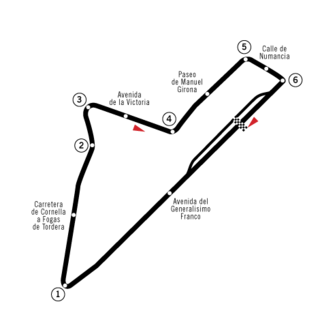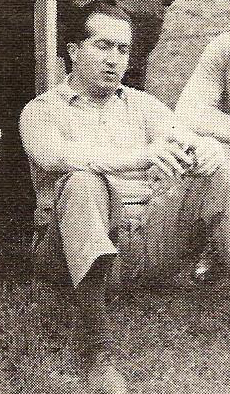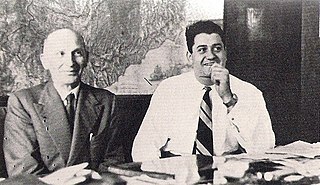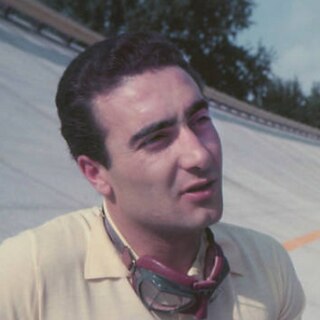
Alberto Ascari was an Italian racing driver and a two-time Formula One World Champion. Noted for careful precision and finely-judged accuracy, Ascari was a multitalented racer who competed in motorcycle racing before switching to cars. He won consecutive Formula One world titles in 1952 and 1953 for Scuderia Ferrari, being the team's first World Champion, and the last Italian to win the title as of 2024. This was sandwiched by an appearance in the 1952 Indianapolis 500, and winning the 1954 Mille Miglia.

Emilio Giuseppe "Nino" Farina, often known by the name Giuseppe Antonio Farina, was an Italian racing driver. He was the Italian National Champion in 1937, 1938, and 1939, and in 1950 became the first World Drivers' Champion during the FIA's inaugural season of Formula One.

The 1952 French Grand Prix was a Formula Two race held on 6 July 1952 at Rouen-Les-Essarts. It was race 4 of 8 in the 1952 World Championship of Drivers, in which each Grand Prix was run to Formula Two rules rather than the Formula One regulations normally used. Unusually this race was run over a duration of 3 hours, rather than a fixed distance.

The 1952 Italian Grand Prix was a Formula Two race held on 7 September 1952 at Monza. It was the eighth and final round of the 1952 World Championship of Drivers, in which each Grand Prix was run to Formula Two rules rather than the Formula One regulations normally used. The 80-lap race was won by Ferrari driver Alberto Ascari after he started from pole position. José Froilán González finished second for the Maserati team and Ascari's teammate Luigi Villoresi came in third.

The 1953 Dutch Grand Prix was a Formula Two race held on 7 June 1953 at the Circuit Zandvoort. It was race 3 of 9 in the 1953 World Championship of Drivers, which was run to Formula Two rules in 1952 and 1953, rather than the Formula One regulations normally used. The 90-lap race was won by Ferrari driver Alberto Ascari after he started from pole position. His teammate Nino Farina finished second and Maserati drivers José Froilán González and Felice Bonetto came in third

The 1954 French Grand Prix was a Formula One motor race held at Reims on 4 July 1954, the same date as the 1954 Football World Cup Final. It was race 4 of 9 in the 1954 World Championship of Drivers. The 61-lap race was won by Mercedes driver Juan Manuel Fangio after he started from pole position. His teammate Karl Kling finished second and Ferrari driver Robert Manzon came in third. This race was held the same day as the 1954 FIFA World Cup Final in Bern, Switzerland, but that event took place later in the day from this Grand Prix.

The 1954 Spanish Grand Prix was a Formula One motor race held on 24 October 1954 at Pedralbes. It was the ninth and final race in the 1954 World Championship of Drivers. The 80-lap race was won by Ferrari driver Mike Hawthorn after he started from third position. Luigi Musso finished second for the Maserati team and Mercedes driver Juan Manuel Fangio came in third.

The 1955 Monaco Grand Prix was a Formula One motor race held at Monaco on 22 May 1955. It was race 2 of 7 in the 1955 World Championship of Drivers and was given an honorary name, Grand Prix d'Europe. The 100-lap race was won by Ferrari driver Maurice Trintignant after he started from ninth position. Eugenio Castellotti finished second for the Lancia team and Maserati drivers Jean Behra and Cesare Perdisa came in third.

The 1955 Formula One season was the ninth season of FIA Formula One motor racing. It featured the sixth World Championship of Drivers, which was contested over seven races between 16 January and 11 September 1955. The season also included several non-championship races for Formula One cars.

The 1954 Formula One season was the eighth season of FIA Formula One motor racing. It featured the fifth World Championship of Drivers, which was contested over nine races between 17 January and 24 October 1954. The season also included several non-championship races for Formula One cars.

The 1953 Formula One season was the seventh season of the FIA Formula One motor racing. It featured the 4th World Championship of Drivers, which was contested over nine races between 18 January and 13 September 1953. The season also included several non-championship races and a separate East German Championship.

The 1952 Formula One season was the sixth season of FIA Formula One motor racing. It featured the 3rd World Championship of Drivers, which was contested over eight races between 18 May and 7 September 1952. The season also included several non-championship races and a separate East German Championship.
The 1950 Formula One season was the fourth season of the FIA's Formula One motor racing. It featured the inaugural FIA World Championship of Drivers, as well as several non-championship races. The championship, which commenced on 13 May and ended on 3 September, consisted of six Grand Prix races, each held in Europe and open to Formula One cars, plus the Indianapolis 500, which was run to AAA National Championship regulations. Giuseppe Farina won the championship from Juan Manuel Fangio and Luigi Fagioli.

Vittorio Jano was an Italian automobile designer of Hungarian descent from the 1920s through 1960s.

Eugenio Castellotti was a racing driver from Italy. He won the 1956 Mille Miglia and 1956 12 Hours of Sebring, and took several Formula One World Championship podiums. His career was cut short by a fatal testing accident at Modena in 1957. He was nicknamed "Il Bello".

The Ferrari 500 was a Formula 2 racing car designed by Aurelio Lampredi and used by Ferrari in 1952 and 1953, when the World Championship was run to F2 regulations.

Scuderia Ambrosiana was an Italian motor racing team that competed in Grand Prix motor racing and the Formula One World Championship. The team was founded in 1937 by drivers Giovanni Lurani, Luigi Villoresi, Franco Cortese and Eugenio Minetti and was named after the patron saint of Milan, Saint Ambrose. The team's cars were painted in blue and black after the colours of F.C. Internazionale Milano, which at the time went under the name Ambrosiana Inter.
This article gives a general overview of motorsport in Italy. For a more exhaustive view see; Motorsport in Italy by decade and Motorsport in Italy by year. Motorsport is widely popular in Italy, and its history spans over a century back to the early 1900s. Today, Italy is considered a hub of motorsport in terms of racing venues, drivers, teams, and manufacturers. It hosts annual races across Formula One, MotoGP, the World Touring Car Cup, and other prominent motor racing series.

Ferrari has manufactured three naturally-aspirated V8 racing engines, designed for Formula One racing. First, the Tipo DS50 engine introduced in 1956; with the 2.5 L engine configuration. Second, the Tipo 205/B engine, introduced in 1964; with the 1.5 L engine configuration; and was designed by Franco Rocchi and Angelo Bellei. Then, a 42-year hiatus; until the FIA imposed a 2.4 L engine V8 configuration for all Formula One teams in 2006, with Ferrari introducing their Tipo 056; designed by Gilles Simon.

The Ferrari Dino 156 F2 was an open-wheel Formula 2 race car, designed, developed, built, and entered into the competition by Italian racing team Scuderia Ferrari.





















